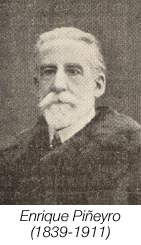3.7.2 The cultivation of literary criticism by Enrique Piñeyro (1839 – 1911)

Enrique Piñeyro’s critical work continued in this period with greater insight. He was recognized as a master in the literary context of his time. He had an eclectic theoretical foundation, drawing on both classicism and the most cherished postulates of romanticism, maintaining a positivist scientific stance. In this sense, he wrote his article “Literature as a Positive Science” in 1864, in which he adopted Taine’s ideas, which he would maintain in essence while still interacting with other aesthetic perspectives.
Although it does not contradict the social purpose of literature that Varona advocates, in a certain sense he advocates for the internalization of this by the individual, so that his art reflects his own feelings and passions, but even with this fundamental thesis, tracing his work one can find divergent assertions.
He began his work in literary criticism and theory with the text “Studies and Conferences on History and Literature,” published in 1880 in New York, which compiled works prepared for Cuban magazines and previous conferences. Varona stated: “Mr. Piñeyro’s book is, without dispute, the most notable literary work that has come out of the pen of any Cuban so far.”
In 1883, he published “Famous Poets of the 19th Century. Their Lives and Works,” in which he explores the long poetic history of the European continent, focusing on the lyrical creations of Byron, Goethe, and Hugo; but also reflecting on other important figures. He also published “Manuel José Quintana (1772–1857). Critical and Biographical Essay” in Paris in 1892, rigorously comparing biographical and literary data, even though his biography did not transcend contemporary sensibilities.
His literary views were based primarily on classicism and romanticism, and he maintained the traditional cult of meter as a sine qua non of poetic expression. Much of his output in this area appears in the “Critical Notes” section of “Revista Cubana,” which also displays a refreshing editorial approach to design and advertising.








